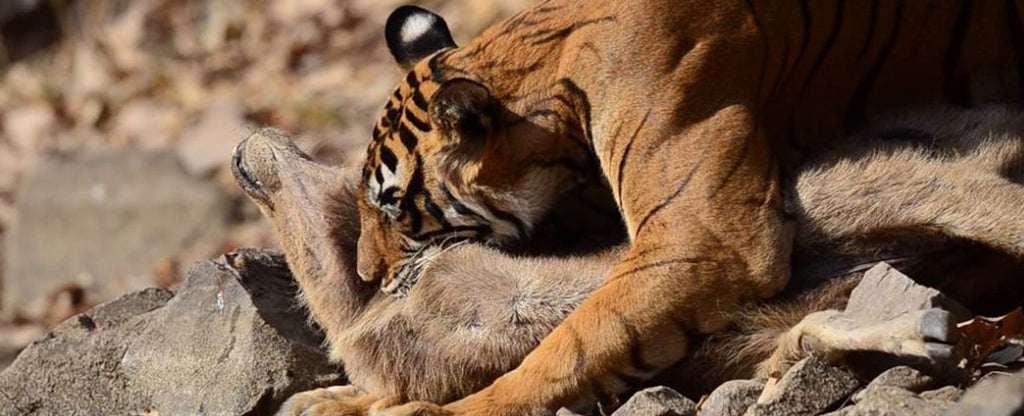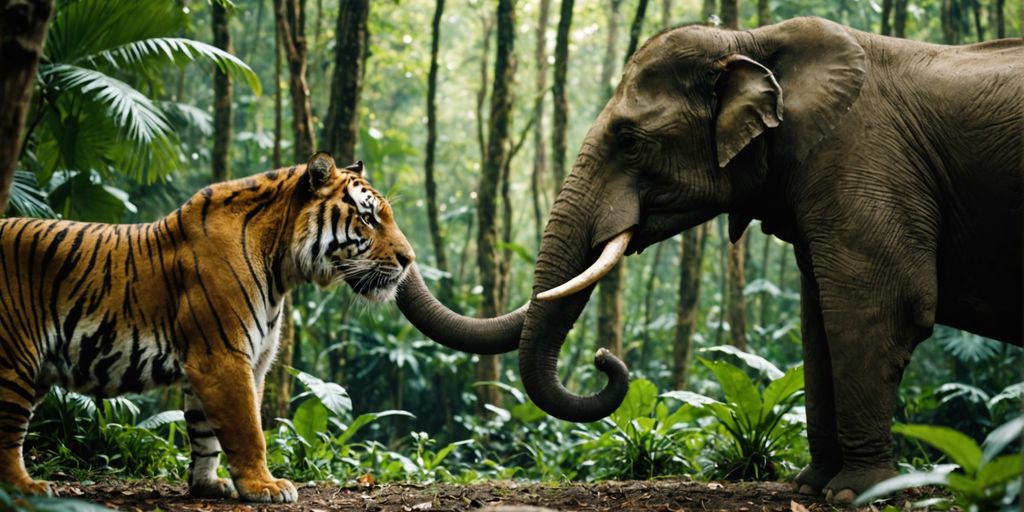Your Cart is Empty
🙏HELP US SAVE TIGERS!🐅 WE DONATE 1% OF OUR SALES TO WILDLIFE ORGANIZATIONS ( WWF ...)
Menu

🙏HELP US SAVE TIGERS!🐅 WE DONATE 1% OF OUR SALES TO WILDLIFE ORGANIZATIONS ( WWF ...)
How does a Tiger Attack its Prey?
May 28, 2021 10 min read

If the Tiger is so well known today, it is as much for its demented power as its reputation as a man-eating animal. Tiger attacks are a testimony to the current conflict between Man and wildlife. Because we want to feel all-powerful, nature has no choice but to calm our ardor most brutally.
The tiger, a wild animal, is one of the most dangerous animals, along with the lion. But the lion attacks from the front, while the tiger tries to attack its victim from behind. To catch its prey, this big cat surrounds it, then reduce the circle little by little.
Since tigers are such powerful hunters, they can go in for a kill by ambush. Tigers will lay in wait above their intended prey and then come down with a pounce when the time is right.
This tactic can be used to attack hoofed animals, such as deer and buffalo. Depending on what area of land you’re in and what prey is most abundant, tigers may ambush their prey from above more than any other way.
Tiger attacks are the deadliest assaults in the animal kingdom. Between 1800 and 2010, an intense study shows that the striped fawn is responsible for more than 350,000 deaths on earth. These carnages are mainly in Asia and, more particularly in India, the Tiger country. To take figures even more hallucinating, it is estimated that during the last five centuries, about 1 million people would have died from the claws of the Tiger.
In China and more globally in South-East Asia, the attacks have progressively decreased until they have become practically null. However, in the Indian region of the Sundarbans, the Tiger has been terrorizing people for more than 30 years. The Tiger attacks on humans are formidable, and few are the survivors.
Tiger attacks always fascinate as much as they frighten the populations. But why do these attacks take place, and what are the consequences? This is what Tiger Empire will try to answer.
The reasons for the Tiger attacks
1) Destruction of habitat and prey

The Tiger is a fantastic animal around which too much misinformation is still circulating. The most important thing to remember is that the big cat never kills for free because Man is not part of its diet. However, when people encroach on its territory, it defends itself with the savage strength it is known for.
Approximately 90 people die each year because of tiger attacks. This number seems paltry compared to the numbers of 100 years ago, but it is still significant. India is most affected by these attacks, especially the Sundarbans region in the south of the country. Moreover, it is not uncommon to see the Tigers more aggressive with humans because of poaching.
In this swampy area, the Tigers find themselves on extremely restricted land. Indeed, human infrastructures have pushed to the cohabitation between the Tiger and the Man. This tense situation leads to mass killings among the populations. It is not uncommon to see a tiger enter villages searching for food. The cohabitation between Man and Tiger is impossible because the big cat will never accept its territory.
In addition to living on a small piece of territory, the Bengal Tiger has great difficulty finding food in the Sundarbans. The swamps are not conducive to the proliferation of herbivores, which creates a real problem for the Tiger to feed correctly. If it cannot find the game of its size, it will fall back on smaller prey such as humans.
These attacks of Tigers mark many Indians. One does not count anymore the scarred and bruised faces testifying a past bite. For them, to come out of an attack "only" seriously wounded is a chance because the feline rarely lets its prey get out alive. The destruction of the Tiger's environment and the lack of game pushes it to attack humans. But this destructive behavior can be explained by other factors.
2) Accidental attacks
The first intention of the big cat is not necessarily to kill humans. Generally speaking, tiger attacks are the result of human carelessness. It was getting too close to a tiger, or disturbing it while feeding tends to make it very angry. This is even more dangerous if it is a Tiger with cubs, as she will be even more aggressive for fear of harming her cubs. This is common sense, but people who don't understand these basic rules are putting themselves at deadly risk.
Other attacks occur because of misidentification by the Tiger. Indeed, when a human crouches, it can easily be mistaken for a sambar or a chital (the Tiger's basic food). A bit like the shark confuses the surfer's board with a turtle; the Tiger confuses the squatting Man with a herbivore.
In addition, to protect yourself from attacks, it is essential not to run or cycle in a place where there are Tigers. Tigers love to chase things in motion, creating real avoidable dramas. For over 20 years, an Indian mailman delivered mail on foot through Tiger territory. He was never attacked or threatened by one of these beasts. One day, he decided to give the mail by bicycle to go faster, because of that a Tiger chased him, and he almost died. So we see the importance of not exciting these striped creatures if we want to survive!
Accidents are not uncommon in zoos. Keeping tigers in captivity requires constant attention, and the slightest negligence can be fatal. Many zookeepers have paid the price, as the Tiger remains a wild animal. In 2019, a zookeeper was attacked by 2 Tigers while she was about to feed them. Fortunately, she survived the attack by both the male and female Tigers. After the study, it seems that they were playing with her rather than anything else.
The most unaware are the visitors who do everything possible to get as close as possible to the big cat. Unfortunately for them, the Tiger rarely gives a second chance. Just watch the video to see how easily the Tiger can kill a human.
3) Man-eating Tigers

In some cases, Tigers can change their diet and become real man-eaters. As a rule, the Tiger's most unfit to hunt deer fall back on humans. It has been observed that "man-eaters" are often old Tigers slowed down by an injury or an illness. Man represents easy prey for them in comparison with their basic food.
Thus, the Tiger would have killed more than 33 000 people in India between 1876 and 1912. Some of them even go as far as attacking elephants to make people fall on their backs and devour them. Even if these cases are rare, they show us that man-eating tigers are not a legend of Indian folklore.
These repeated attacks are also evidence of developing a habit of human hunting in the orange beast. There are many accounts by specialists describing Tigers feeding only on human flesh. This is because a tiger can kill a human compared to its failures in hunting herbivores. When attacking a human, the striped fawn is almost 100% successful; on the other hand, it hardly reaches 10% with a chital. However, it seems that the Tiger does not have a particular preference for human flesh.
During the wars, Tigers made carnages within the troops of soldiers. The big cat was almost more feared than the enemy because of its latter. Entire regiments were decimated by these animals, which today are known as "man-eaters." Their attacks were discreet but lightning fast.
They usually surprise their victims from behind because it seems that the Tigers do not attack when they are spotted. It is almost impossible to spot the Tiger in the vegetation of the jungles and savannahs. It, therefore, takes advantage of this to attack dazzlingly by biting its prey on the neck. Thanks to its powerful canines, it takes less than 10 seconds to kill a man.
Protect yourself from the onslaught of the big cat with our Tiger Pendants ⤵️
Precautions and measures put in place
1) Giving the Tiger more space

As you know, the Tiger is a very territorial animal. This means that it will not tolerate the presence of intruders on its land, let alone humans. Many tiger attacks are carried out for the sole purpose of defending their environment. These primal instincts are not intended to feed on human flesh. But they have the will to repel the invader.
To prove this, we can give you the example of a Tigress who killed eight people wandering on her territory. She and her cubs did not even feed on the carcasses of the dead, which shows that the family did not need food. The cohabitation between man and Tiger being impossible, the authorities decided to offer more space to the big cat.
These developments have been implemented at the expense of the population; some villages have even been completely moved. The measures put in place seem to be effective because we can see a decrease in the number of Tiger attacks in the regions concerned. But in some cases, this simple arrangement of the territory is not enough, and the state has to use it the hard way.
2) More controversial solutions

It's pretty rare, but it's essential to talk about it; it sometimes happens that Tigers become uncontrollable. They go on a mass killing spree and decimate entire villages. The local populations then set up real hunts for the Tigers to kill the person responsible for the crimes that ravage their community.
The problem of man-eating tigers often comes from the reintroduction of these animals in their natural environment. The problem with man-eating tigers is that they are often reintroduced to their natural habitat, as they are accustomed to the presence of humans in an enclosure, a zoo, or even a circus. In this way, they are much less afraid of humans, and if hunger is felt, they do not hesitate to help themselves!
Even if the Tiger is a highly protected species, authorities sometimes have no other choice than to shoot them. Indeed, many Tigers were captured after having killed a man but released immediately in nature. As a result of this behavior of the Indian government, which put the Tiger before its population, voices were raised. So much so that today, the authorities are obliged to take actual decisions if they do not want to have a revolt of the village.
In the best case, the hunt for the Tigers leads to the capture of the man-killer. In the worst case, he is killed on the spot to prevent him from running away. If he is captured, his condition and ability to evolve in captivity will decide his fate. The authorities will determine if he should be killed because he is too dangerous or if he can be raised in a zoo or a reserve.
Other measures have been put in place by the villagers, such as wearing a mask on the back of the head during expeditions within the Tiger's land. According to them, the latter will not attack if he realizes that he is spotted, hence the usefulness of the masks. This strategy is moderately effective, even if it is true that the orange feline always prefers to attack from behind.
More far-fetched techniques have been developed, such as electrifying human dummies so that the Tigers register that they should not attack humans. Or they are releasing prey such as pigs into the wild so that the Tiger will attack them rather than humans. These two projects proved ineffective and were quickly abandoned.
The three most deadly tigers
1) The Champawat Tiger

The Champawat Tiger was a man-eating Tigress who is said to have killed nearly 200 men and women before being driven out of Nepal. She settled in the Champawat district of the northern Indian state of Uttarakhand. She did not stop there and continued to kill, bringing the total number of her victims to 436. She was finally found and shot in 1907. It is known that it entered villages, even in broad daylight, its roar creating panic and making people flee to their makeshift homes.
2) The Chowgarh Killers
The Chowgarh Tigers were a pair of man-eating Bengal Tigers, consisting of an old Tigress and her cub. Over five years, they killed 64 people in the eastern division of Kumaon, Uttarakhand, in northern India, covering a territory of 3,900 km². However, the figures are uncertain as indigenous people in areas frequented by the Tigers have claimed twice that number.
Moreover, they do not consider victims who survived direct attacks but died afterward. The two tigers were killed by Jim Corbett, the most famous hunter of "man-eating" Tigers. The national park "Jim Corbett" gave its name to pay tribute to this wildlife lover.
3) The man-eater of Bhimashankar

One story was discovered by Pune-based author Sureshchandra Warghade when he met an old villager in a forest near his home. The villager told him how a man-eating Tiger terrorized the entire Bhimashakar region for two years in the 1940s. He was a police officer in that area and was responsible for handling death paperwork (missing person reports and death certificates) and other duties such as assisting in hunting parties.
During this period, the Tiger has killed more than 100 people, but he meticulously disposed of their remains, with only two bodies ever being found. Several hunts were organized, but the only effective one was that of an Ambegaon-based hunter named Ismail. On his first attempt, Ismail had a confrontation with the Tiger and came close to being killed. He then called his friend Kenneth Anderson, and the two of them went back to eliminate the man-eater. The Tiger mostly killed the villagers sleeping outside the huts and the village.
The authenticity of the story told by the villager was confirmed when official reports were examined in addition to the certificate issued by the British authorities after killing the man-eating Tiger.
In summary

Tiger attacks do not happen by chance but rather reflect a disregard for natural laws. All wild animals have the predatory instinct to defend their natural habitat. In tourist sites such as safaris, humans come to disturb the Tiger for their pleasure. It is not surprising that this Asian animal wants to be respected to live in peace, away from tourists.
With its sharp claws, this species is not made to live with human presence. Its dangerousness knows very few limits; it can break your neck in less than 2 seconds, that's to say!
The big cats such as the Tiger must therefore benefit from an exceptional treatment so that we can ensure their conservation while avoiding new massacres. India has understood this by setting up numerous reserves on a large part of its territory. Thanks to these actions, the Tigers can hunt the deer herds in peace and leave the local populations alone.
The Tiger is an endangered animal; some of its subspecies have already disappeared. It is urgent to preserve the image of this critically endangered creature among the general public if we want to conserve it. To demonize this big cat without knowing the actual causes of its actions can only lead to an even greater endangerment of the animal.
"Man is born perfectible; the animal is born perfect.
Louis de Bonald
Make your little one happy and give him or her one of our Tiger Figurines⤵️
Also in Tiger Blog

Sloth Bear vs Tiger: Who Would Win?
July 13, 2024 7 min read
Explore the thrilling showdown between a sloth bear and a tiger, analyzing their strengths, behaviors, and survival tactics.
Read More
Tiger vs Elephant: Who Reigns Supreme in the Animal Kingdom?
July 13, 2024 7 min read
Explore why elephants usually triumph over tigers in the wild, highlighting their size, strength, and defensive prowess.
Read More
Epic Battle: Polar Bear vs Tiger, who win?
July 11, 2024 8 min read
Epic showdown: Polar Bear vs Tiger. Discover who would win in this thrilling battle of nature's fiercest predators.
Read More
